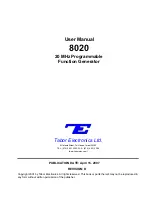
6
Drücken Sie den Drucktaster am Weichen-
decoder einmal. Die Zunge der Weiche
schaltet langsam hin und her.
Drücken Sie nun den Drucktaster ein zweites
mal. Die Weichenzunge schaltet in einem
anderen Rhythmus.
Jetzt drücken Sie an der Mobile Station eine
der 4 Funktionstasten f1 ... f4 (linke Tasten-
reihe). Hat der Decoder die Adresse akzep-
tiert, schaltet die angeschlossene Weiche
noch einmal langsam hin und her. Die Pro-
grammierung ist damit abgeschlossen.
Bei jedem Druck auf die gerade gewählte
Funktionstaste schaltet die Weiche nun auf
eine andere Stellung: Abzweigend - gerade-
aus - abzweigend - geradeaus ...
The turnout switches back and forth in anoth-
er rhythm.
Now press one of the 4 auxiliary function but-
tons f1 ... f4 of the Mobile Station (to the left
of the display). If the decoder has accepted
the address, the turnout switches back and
forth again slowly a few times. Then the pro-
gramming has been finished.
With every press on the auxiliary function
button the turnout changes to another direc-
tion: branch off - straight - branch off -
straight ...
Achtung!
Die Mobile Station 60652 aus den Start-
packungen ist schwächer als die separat
erhältliche 60651. Sie kann nicht genug
Strom für ein sicheres Schalten liefern. Bitte
verwenden Sie dann die separate
Schaltstromeinspeisung nach Abbildung 2.
Attention!
The Mobile Station 60652 supplied with the
starter sets is less powerful as the 60651
which is available separatly. It isn't able to
provide enough current for a save switching.
In this case please use the separate current
supply according to figure 2.
c) DCC
An advantage of using a DCC address is the
big range of 2,040 accessory addresses.
To enter the programming mode you have to
press the push button switch on the decoder
three times. After each press wait until the
acknowledgement of the turnout has fin-
ished. After the third press the turnout will
switch fast back and forth a few times.
Now send a turnout switching command to
which the turnout shall react. In which direc-
tion you switch while programming doesn't
care. Of cause, you can also send a switch-
ing command by a railroad control software
from your computer (e.g.
Viessmann
1011
WIN-DIGIPET).
With modern central units you also can use
the special symbol for a turnout.
If the decoder has accepted the address, the
turnout switches again back and forth slowly
a few times. Then the programming of a
DCC address has been finished.
d) Roco "Lokmaus 2"
The "Lokmaus 2" from Roco is not able to
generate switching commands for magnetic
devices. But you can program the 5231 to a
function key of a DCC locomotive address.
Proceed like described in section b). Merely
you have to press the push button switch of
the 5231 four times instead of two times.
With a fifth push on the address button
you can leave the address programming
mode without any changes.
c) DCC
Ein Vorteil einer Programmierung auf eine
DCC-Adresse ist der riesige Adressumfang
von 2.040 Magnetartikeladressen.
Um in den Programmiermodus zu gelangen,
drücken Sie dreimal auf den Taster des De-
coders, und warten jedesmal die Bestätigung
ab. Nach dem dritten Tastendruck schaltet
die Weiche einige Male schnell hin und her.
Senden Sie nun an Ihrem DCC-Digitalsys-
tem einen Magnetartikel-Schaltbefehl, auf
den die Weiche reagieren soll. In welche
Richtung Sie bei der Programmierung schal-
ten, ist völlig gleich. Alternativ können Sie
auch einen Weichenschaltbefehl über ein
Modellbahn-Steuerungsprogramm Ihres
Computers (z. B. WIN-DIGIPET) auslösen.
Hat der Decoder die Adresse akzeptiert,
schaltet die angeschlossene Weiche noch
einmal langsam hin und her. Die Program-
mierung ist damit abgeschlossen.
d) Roco Lokmaus 2
Die Lokmaus 2 von Roco kann keine Schalt-
befehle für Magnetartikel erzeugen. Sie kön-
nen jedoch den 5231 auf eine Funktionstaste
einer DCC-Lokadresse programmieren. Ge-
hen Sie dazu entsprechend dem Abschnitt b)
vor. Sie müssen lediglich viermal auf den
Drucktaster des 5231 drücken anstatt zwei-
mal.
7
5. Anschluss mit
Powermodul 5215
5. Connection with Power
Module 5215
Zur Erzielung der optimalen Schaltleistung
bei besonders problematischen Antrieben (z.
B. die C-Gleis-Antriebe der ersten Genera-
tion) empfehlen wir den Einsatz unseres
Powermoduls 5215 gemäß Abbildung 4.
To get the optimum switching power especi-
ally for problematic electric mechanisms (like
the first generation of C-track mechanisms)
we recommend the use of our power module
5215 like it is shown in figure 4.
Abbildung 3
Figure 3
4. Einbau
4. Mounting
Now
the decoder from the power
supply again. After that press the decoder
board very carefully on the mounting pins of
your C-track turnout. Don't jam any wire and
take care that there arise no short circuits
between cable shoes and the printed circuit
board resp. the metal parts of the turnout.
Please stick a label on the back of the deco-
der board and write the decoder address on
it, so you can’t forget the decoder’s address!
disconnect
Kabel vorsichtig
verstauen
stow away the
wires carefully
Trennen Sie nun den Decoder wieder von
der Digitalzentrale bzw. Stromversorgung.
Danach drücken Sie den Decoder vorsichtig
auf die Befestigungsstifte der C-Gleis-Wei-
che auf. Achten Sie dabei darauf, dass keine
Kabel eingeklemmt werden und keine Kurz-
schlüsse zwischen den Kabelschuhen und
der Leiterplatte bzw. den Metallteilen der
Weiche entstehen (Abbildung 3).
Kleben Sie als Gedankenstütze ein kleines
Selbstklebeetikett mit der Decoderadresse
auf die Rückseite der Leiterplatte.
You can repeat this programming process
as often as you want.
Mit einem fünften Druck auf den Taster
des Decoders verlassen Sie ohne Verän-
derung der Adresse den Adress-Program-
miermodus.
Die beschriebenen Programmiervorgänge
können beliebig oft wiederholt werden.
Tipp:
Tip:
Für C-Gleis-
Dreiweg
weichen (diese ha-
ben 2 Antriebe) gibt es von
Viessmann
den Dreiwegweichendecoder 5235.
Particularly for C-track
three-way
turn-
outs (which have got two electric mecha-
nisms) we recommend our decoder for
three-way turnouts 5235.

























